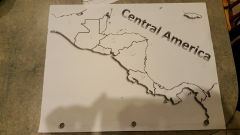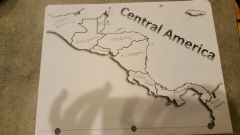![]()
![]()
![]()
Use LEFT and RIGHT arrow keys to navigate between flashcards;
Use UP and DOWN arrow keys to flip the card;
H to show hint;
A reads text to speech;
22 Cards in this Set
- Front
- Back
|
Glaciers are masses of _____ ice created by the natural forces of _______ snow. |
moving compacting |
|
|
A _____ is an almost motionless mass of ______ snow and ice that accumulates year after year. It is only considered a glacier if it is moving. |
snowfield permanent |
|
|
Random melting occurs periodically, and then it _____. This changes the snow into ice crystals called ___. |
refreezes firn |
|
|
In the deepest layer, the pressure of the layers above flattens the ice and squeezes out any ____. the firn loses its white color, turning a bright , ___-___ color. |
air steel-blue |
|
|
A glacier is formed when _____ begins to pull the ice and snow down-slope. |
gravity |
|
|
Glacier growth depends on the balance between snowfall received and the amount of ice lost due to _____ and ______. More snow has to fall than the amount of water evaporating in order for ____ to occur. |
melting and evaporation growth |
|
|
There are two types of glaciers. They are classified by their ____ and ____ they are formed. |
size where |
|
|
Valley glaciers are long, narrow ____-shaped masses of ice. They form in high mountain regions. After they melt away, a _- shaped valley is left behind due to the bottom of the glacier ____ the valley floor away. |
wedge U eroding |
|
|
Continental ice sheets are ______ that cover large area of land. They occupy _____ of square kilometers of land. |
glaciers millions |
|
|
Today, continental ice sheets only cover ____ and _______. |
Greenland Antarctica |
|
|
Although glaciers are referred to as ____ of ice, they do not flow as freely as __(same)__. |
rivers |
|
|
Glaciers move of average ___ km/yr. |
100 |
|
|
Glaciers move by 2 processes- ____ ___ and ____ ____ ___. |
basal-slip internal plastic flow |
|
|
Basal slip. The weight of the ice adds enough ____ to melt the ice where it comes in contact with the ground at the bottom of the ____. |
pressure glacier |
|
|
Basal slip. The water from the melted ice acts as a ______ (making it slippery) between the base of the ice and the ____ that it sits on. This allows ice to move ____ by slipping at the bottom. |
lubricant rock forward |
|
|
Internal plastic flow occurs when the ice crystals inside the glacier ____ over each other, causing a slow forward motion. (Yes, even solid ice can flow with enough weight and _____!) |
slip pressure |
|
|
Since the ______ of the glacier is not under as much pressure, it remains _____. |
surface brittle |
|
|
The surface buckles and cracks from the pressure creating _____. |
crevasses |
|
|
Continental ice sheets move outward in ___ directions from their center, eventually flowing into the ocean forming ___ _____. |
all ice shelves |
|
|
The ocean waves break pieces off the ice shelves creating _____ (large chunks of ice that float out into the ocean). |
icebergs |
|
|
Icebergs are mostly under water with just the ___ part above the surface. |
top |
|

|

|

